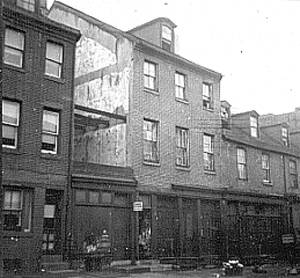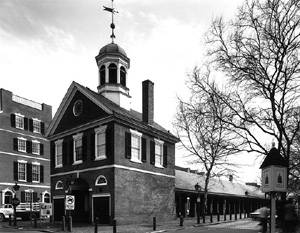
One of Philadelphia's oldest neighborhoods, Society Hill is near the downtown business district and adjacent to Independence National Historical Park, where Independence Hall, the Liberty Bell, and other colonial-era attractions are located. The name Society Hill reflects the community's history, not its current appearance or status. A hill once existed at the area's eastern border, on the bank of the Delaware River. As commerce grew and docks and warehouses multiplied, the hill was gradually flattened. The word "society" comes from the Free Society of Traders in Pennsylvania, a late-17th-century land-investment company founded by William Penn. Society Hill became home to many leaders of post-colonial America, particularly between 1790 and 1800, when Philadelphia was the nation's capital.
Society Hill today extends roughly from Front to 8th streets and from Walnut to Lombard streets. Society Hill contains the largest concentration of 18th-century architecture in the United States. As part of a post-World War II redevelopment plan, more than 800 houses in the area were restored during a two-decade period, beginning in the mid-1950s. Although most of these properties are private, single-family homes, two house museums are open to the public: the Hill-Physick-Keith House (1786) at 321 South Fourth Street and the Powel House (1765) at 244 South 3rd Street.
One of America's most
walkable neighborhoods, Society Hill is laid out in a grid of tree-lined
streets with brick pavements and a network of pedestrian alleys interspersed
with small parks. Public transportation, tourist attractions, and downtown
shopping are all readily accessible. The lively restaurants and night
spots of the South Street area are one block from Society Hill's southern
edge. The art galleries and cultural attractions of the Old City area
lie a few blocks from the northern edge. Penn's Landing (a portion of
the Delaware River waterfront) is just east of Society Hill. Its riverside
walkway leads to restaurants, a Hyatt Hotel, and the River Link Ferry.
![]()


Georgian-style headhouse built in 1804 at 2nd and Pine Streets. Attached
to a 16-stall, open-air market shed, it served as an early fire station.
Both structures were restored in 1960, as seen in this 1982 photograph.
TOP • NEXT PAGE • LIST OF TOUR STOPS • MAP • P.N.R.T. HOME • YOUR COMMENTS